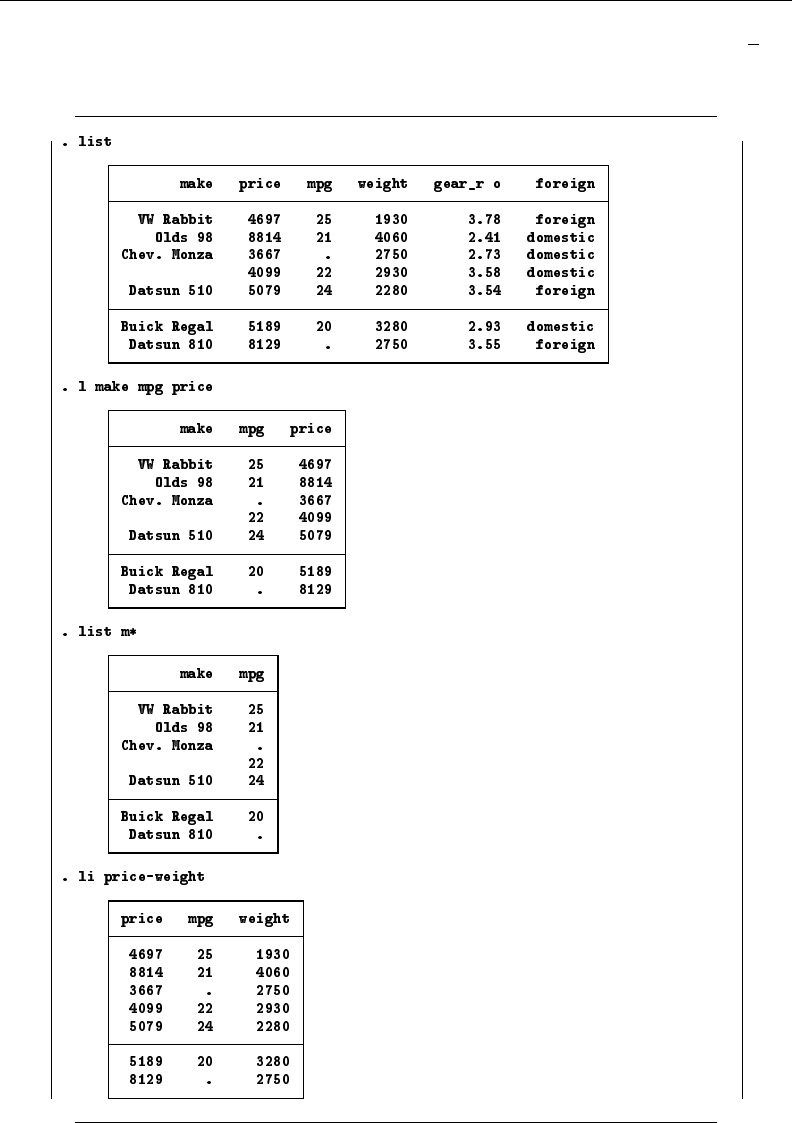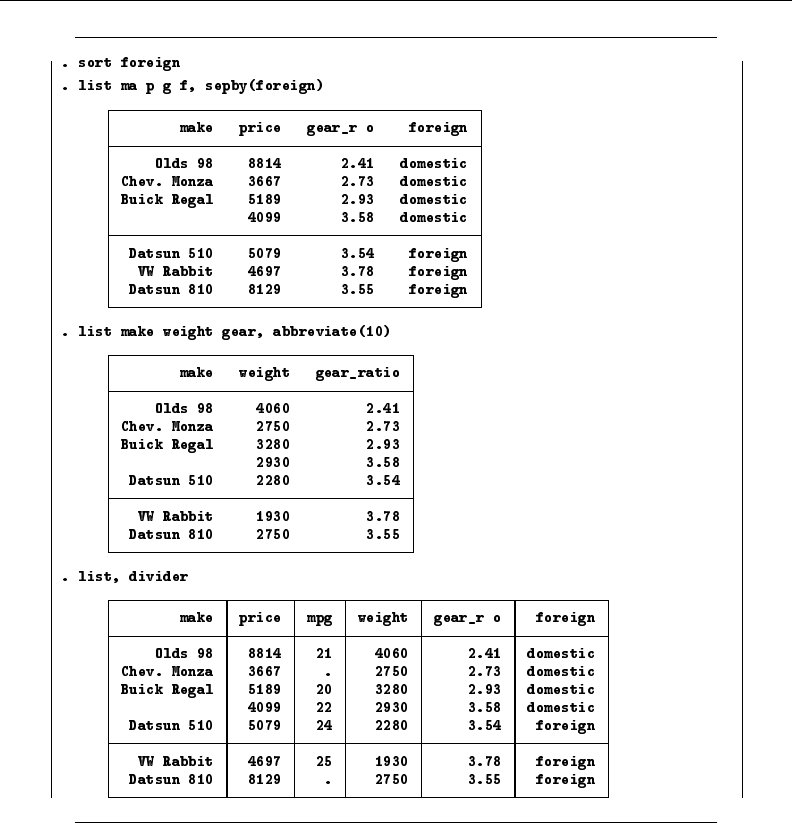
10 Listing data and basic command syntax
Command syntax
This chapter gives a basic lesson on Stata’s command syntax while showing how to control the
appearance of a data list.
As we have seen throughout this manual, you have a choice between using menus and dialogs
and using the Command window. Although many find the menus more natural and the Command
window baffling at first, some practice makes working with the Command window often much faster
than using menus and dialogs. The Command window can become a faster way of working because
of the clean and regular syntax of Stata commands. We will cover enough to get you started; help
language has more information and examples, and [U] 11 Language syntax has all the details.
The syntax for the list command can be seen by typing help list:
list
varlist
if
in
, options
Here is how to read this syntax:
• Anything inside square brackets is optional. For the list command,
a. varlist is optional. A varlist is a list of variable names.
b. if is optional. The if qualifier restricts the command to run only on those observations for
which the qualifier is true. We saw examples of this in [GSW] 6 Using the Data Editor.
c. in is optional. The in qualifier restricts the command to run on particular observation
numbers.
d. , and options are optional. options are separated from the rest of the command by a
comma.
• Optional pieces do not preclude one another unless explicitly stated. For the list command,
it is possible to use a varlist with if and in.
• If a part of a word is underlined, the underlined part is the minimum abbreviation. Any
abbreviation at least this long is acceptable.
a. The l in list is underlined, so l, li, and lis are all equivalent to list.
• Anything not inside square brackets is required. For the list command, only the command
itself is required.
Keeping these rules in mind, let’s investigate how list behaves when called with different arguments.
We will be using the dataset afewcarslab.dta from the end of the previous chapter.
list with a variable list
Variable lists (or varlists) can be specified in a variety of ways, all designed to save typing and
encourage good variable names.
• The varlist is optional for list. This means that if no variables are specified, it is equivalent to
specifying all variables. Another way to think of it is that the default behavior of the command
is to run on all variables unless restricted by a varlist.
• You can list a subset of variables explicitly, as in list make mpg price.
• There are also many shorthand notations:
m* means all variables starting with m.
price-weight means all variables from price through weight in the dataset order.
ma?e means all variables starting with ma, followed by any character, and ending in e.
1
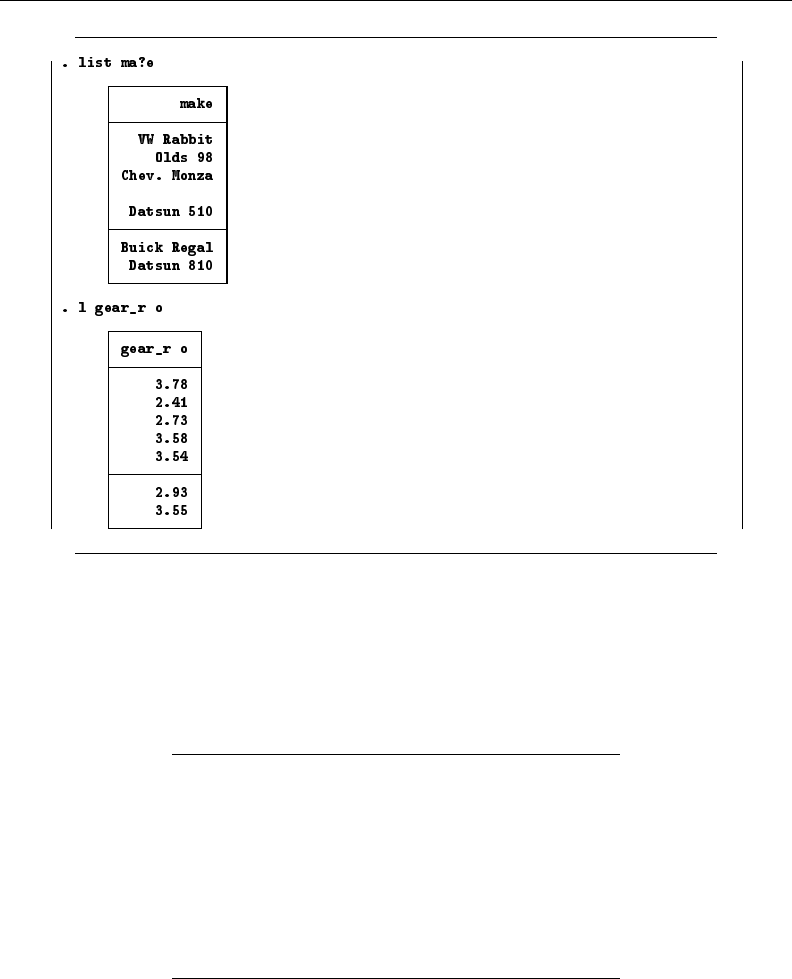
[ GSW ] 10 Listing data and basic command syntax 3
1.
2.
3.
4.
5.
6.
7.
~
~
1.
2.
3.
4.
5.
6.
7.
list with if
The if qualifier uses a logical expression to determine which observations to use. If the expression
is true, the observation is used in the command; otherwise, it is skipped. The operators whose results
are either true or false are
< less than
<= less than or equal
== equal
> greater than
>= greater than or equal
!= not equal
& and
| or
! not (logical negation;
~
can also be used)
() parentheses are for grouping to specify order of evaluation
In the logical expressions, & is evaluated before | (similar to multiplication before addition in
arithmetic). You can use this in your expressions, but it is often better to use parentheses to ensure
that the expressions are evaluated in the proper order. See [U] 13.2 Operators for complete details.
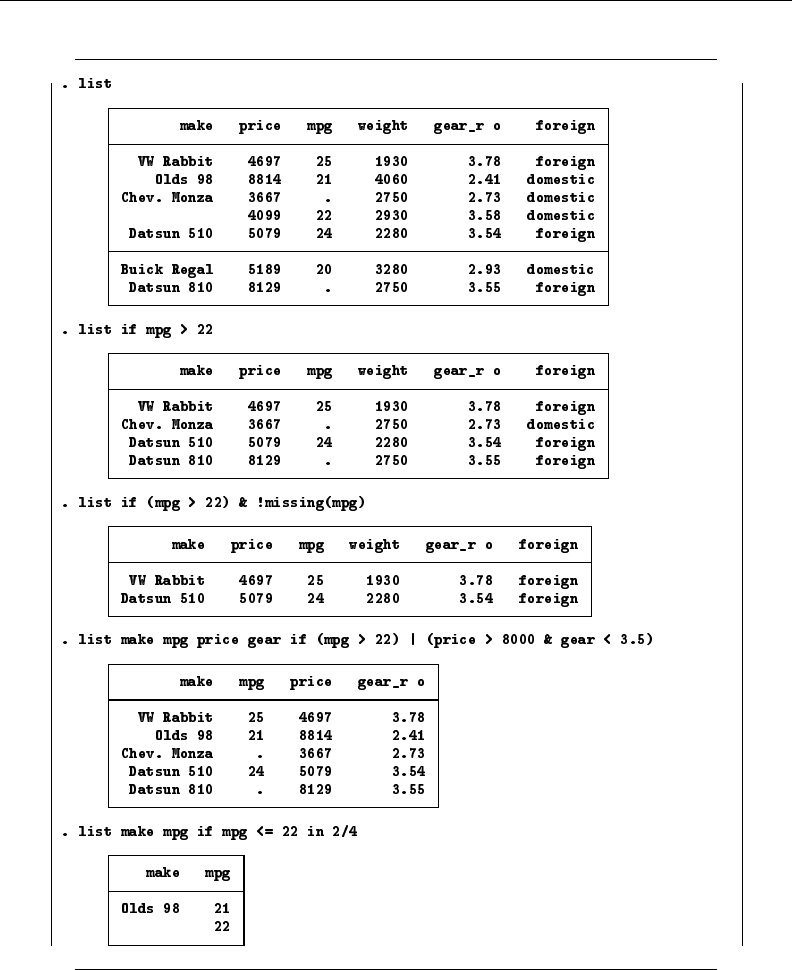
4 [ GSW ] 10 Listing data and basic command syntax
~
1.
2.
3.
4.
5.
6.
7.
~
1.
3.
5.
7.
~
1.
5.
~
1.
2.
3.
5.
7.
2.
4.
In the listings above, we see more examples of Stata treating missing numerical values as large values,
as well as the care that should be taken when the if qualifier is applied to a variable with missing
values. See [GSW] 6 Using the Data Editor.
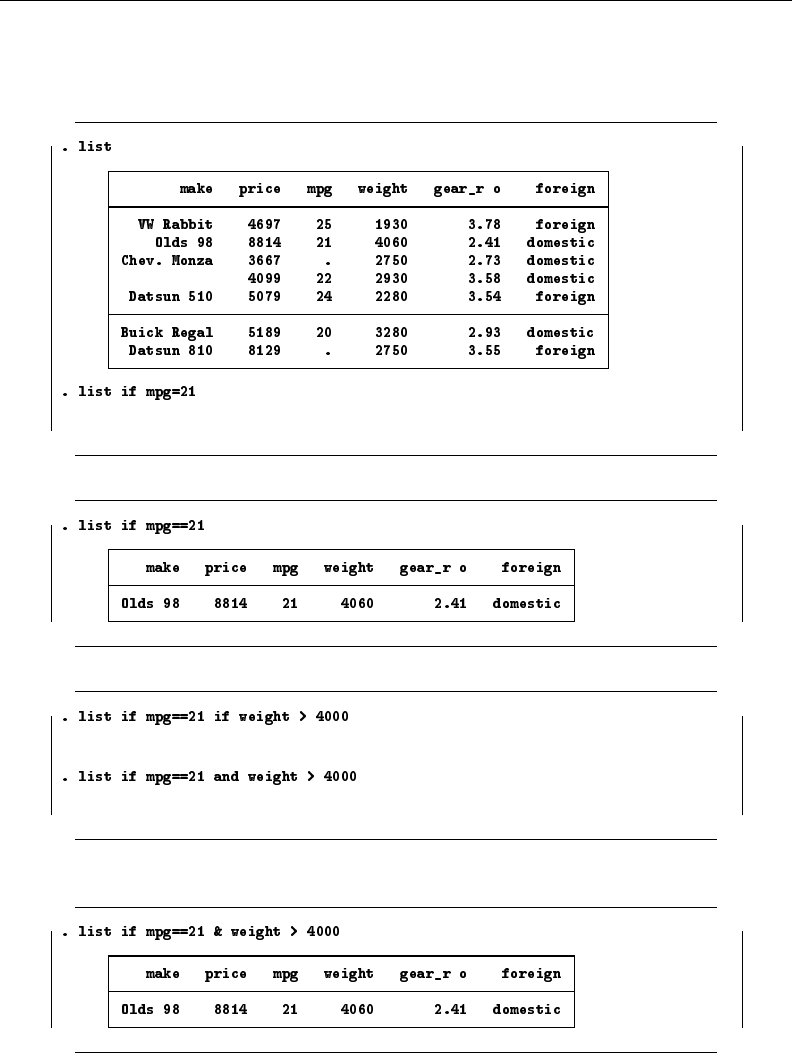
[ GSW ] 10 Listing data and basic command syntax 5
list with if, common mistakes
Here is a series of listings with common errors and their corrections. See if you can find the errors
before reading the correct entry.
~
1.
2.
3.
4.
5.
6.
7.
=exp not allowed
r(101);
The error arises because “equal” is expressed by ==, not by =. Corrected, it becomes
~
2.
Other common errors with logic:
invalid syntax
r(198);
invalid ’and’
r(198);
Joint tests are specified with &, not with the word and or multiple ifs. The if qualifier should be
if mpg==21 & weight>4000, not if mpg==21 if weight>4000. Here is its correction:
~
2.
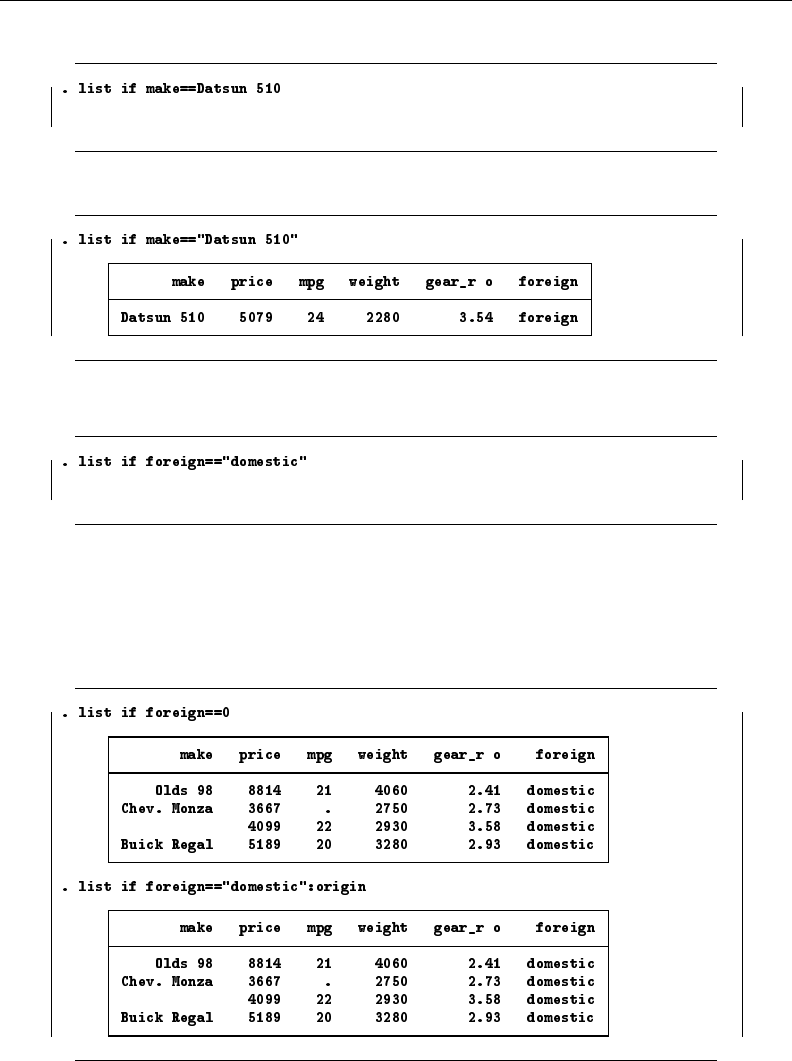
6 [ GSW ] 10 Listing data and basic command syntax
A problem with string variables:
Datsun not found
r(111);
Strings must be in double quotes, as in make=="Datsun 510". Without the quotes, Stata thinks that
Datsun is a variable that it cannot find. Here is the correction:
~
5.
Confusing value labels with strings:
type mismatch
r(109);
Value labels look like strings, but the underlying variable is numeric. Variable foreign takes on values
0 and 1 but has the value label that attaches 0 to “domestic” and 1 to “foreign” (see [GSW] 9 Labeling
data). To see the underlying numeric values of variables with labeled values, use the label list
command (see [D] label), or investigate the variable with codebook varname. We can correct the
error here by looking for observations where foreign==0.
There is a second construction that also allows the use of the value label directly.
~
2.
3.
4.
6.
~
2.
3.
4.
6.
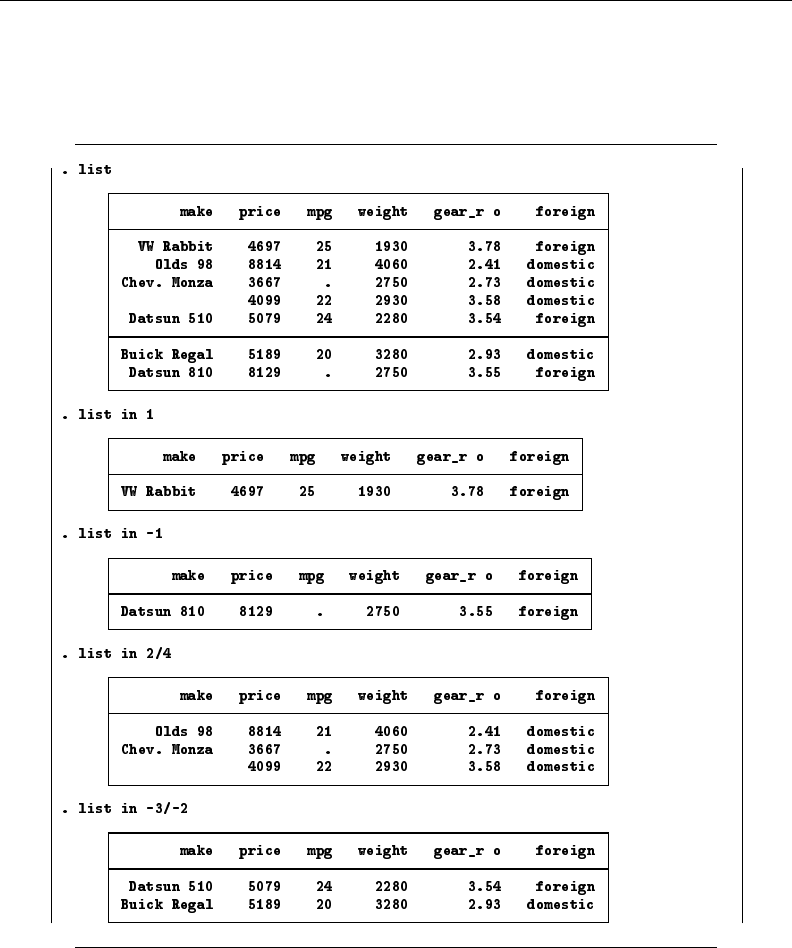
[ GSW ] 10 Listing data and basic command syntax 7
list with in
The in qualifier uses a numlist to give a range of observations that should be listed. numlists
have the form of one number or first/last. Positive numbers count from the beginning of the dataset.
Negative numbers count from the end of the dataset. Here are some examples:
~
1.
2.
3.
4.
5.
6.
7.
~
1.
~
7.
~
2.
3.
4.
~
5.
6.
Controlling the list output
The fine control over list output is exercised by specifying one or more options. You can use
sepby() to separate observations by variable. abbreviate() specifies the minimum number of
characters to abbreviate a variable name in the output. divider draws a vertical line between the
variables in the list.
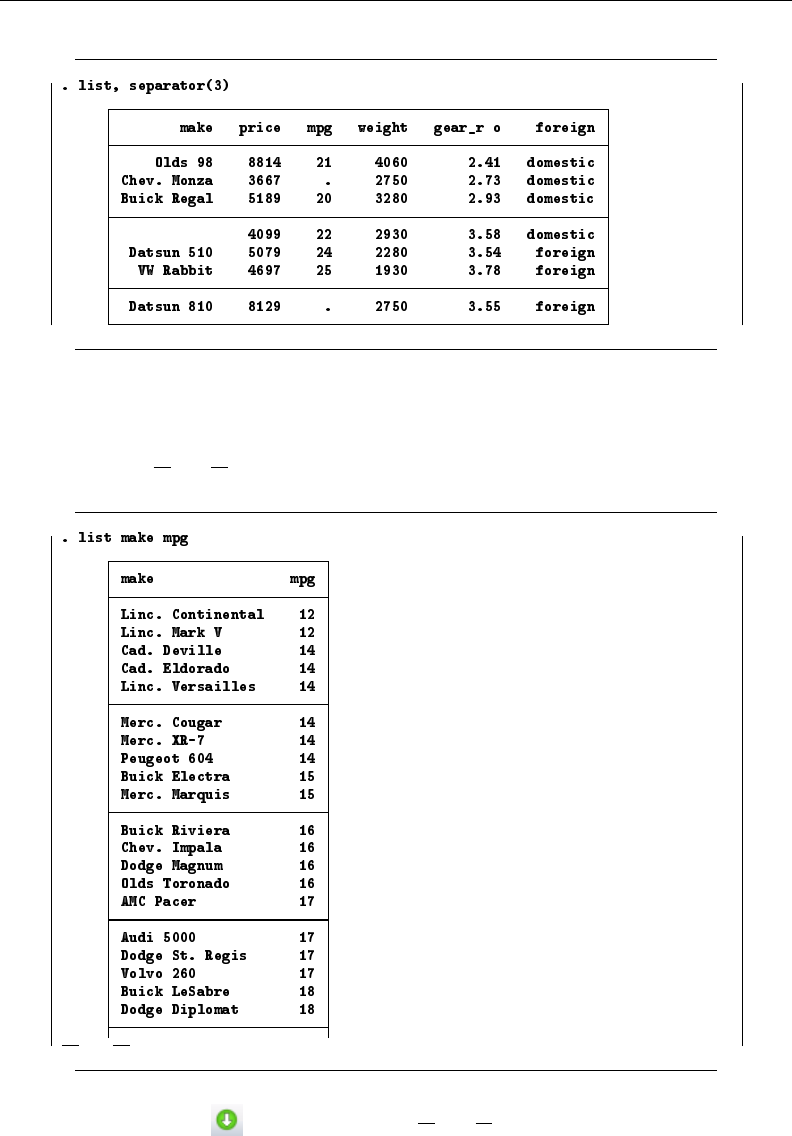
[ GSW ] 10 Listing data and basic command syntax 9
~
1.
2.
3.
4.
5.
6.
7.
More
When you see a more prompt at the bottom of the Results window, it means that there is more
information to be displayed. This happens, for example, when you are listing many observations.
1.
2.
3.
4.
5.
6.
7.
8.
9.
10.
11.
12.
13.
14.
15.
16.
17.
18.
19.
20.
more
If you want to see the next screen of text, you have a few options: press any key, such as the Spacebar;
click on the More button, ; or click on the blue more at the bottom of the Results window.
To see just the next line of text, press Enter.
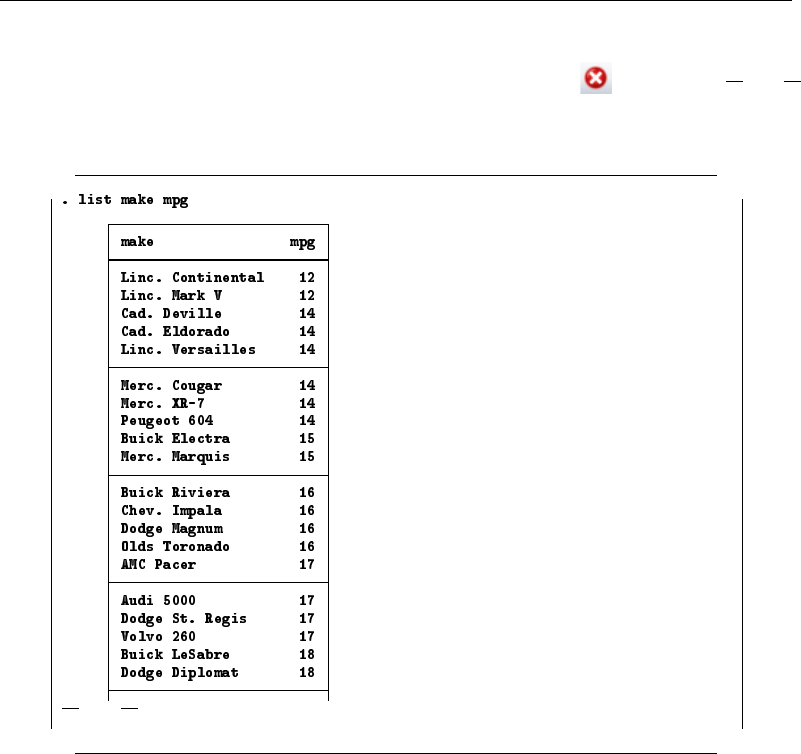
10 [ GSW ] 10 Listing data and basic command syntax
Break
If you want to interrupt a Stata command, click on the Break button, . If you see a more
prompt at the bottom of the Results window and wish to interrupt it, click on the Break button or
press q.
1.
2.
3.
4.
5.
6.
7.
8.
9.
10.
11.
12.
13.
14.
15.
16.
17.
18.
19.
20.
break
r(1);
It is always safe to click on the Break button. After you click on Break, the state of the system is
the same as if you had never issued the original command.
